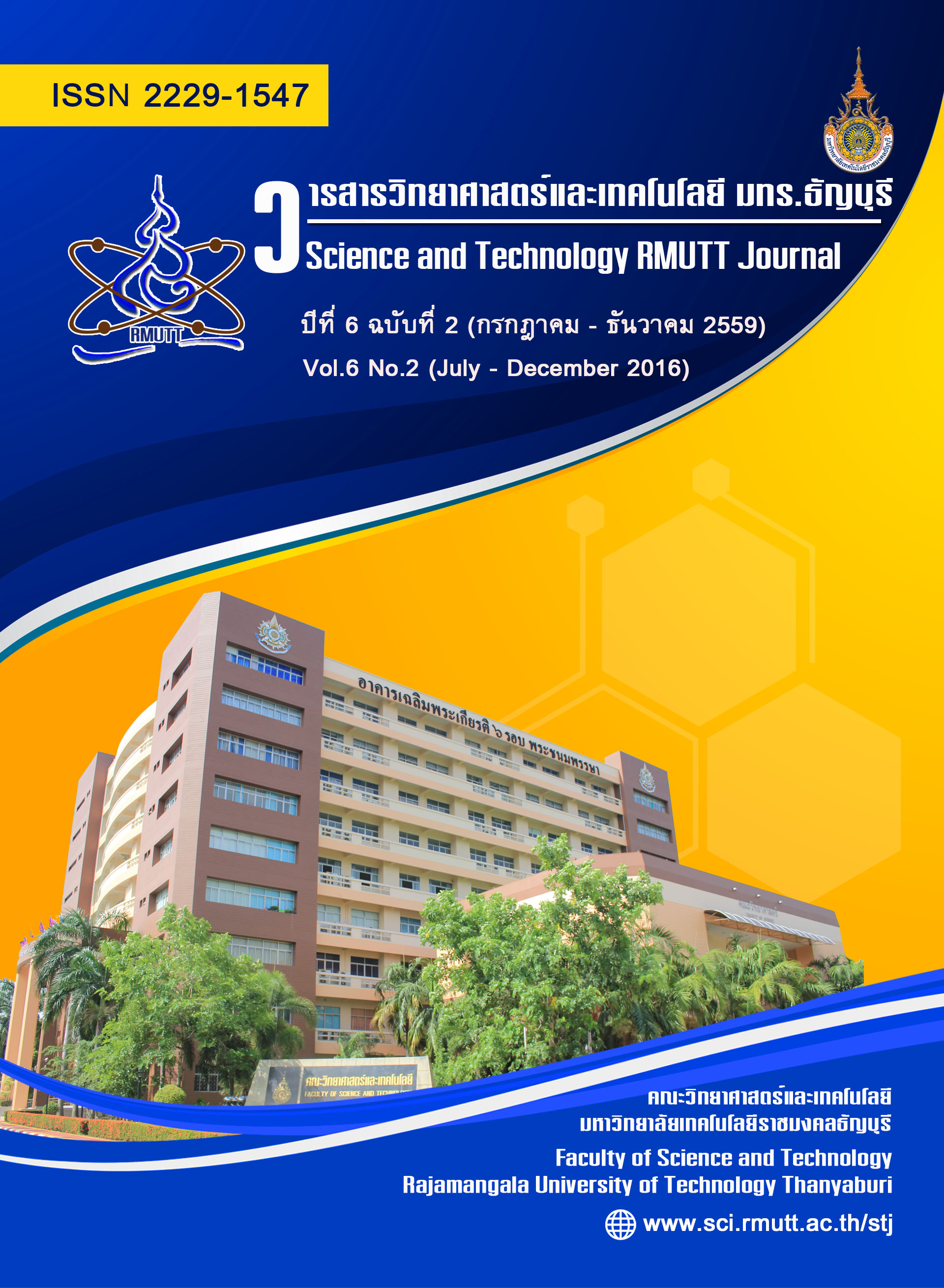Using Nitrogen Fixing Bacteria with Biological Supporting Media for Promoting the Plant Growth
Main Article Content
Abstract
This research was aimed to isolate of nitrogen fixing bacteria and study on structure of dried water hyacinth stem as a biological supporting media for bacterial immobilization to using them for enhancing the growth of Chinese Kale. (Brassica alboglabra) Six nitrogen fixing bacteria were isolated from soil and designed as RD01, RD02, RD03, RD04, RD05, and RD06. The result showed that RD02 is effective isolate of nitrogen fixing capability and growth characteristic which was the maximum of ammonia-nitrogen in nitrogen-free medium found 6.42 mg NH3-N/L for72 hours of incubation. Colony, morphology and some biochemical characteristics of RD 02 showed that it similar to Azotobacter sp. Inside of the supporting media found a large tube at the center surrounded by microtubules that affected for bacterial cell collecting. 5.4 x 104 CFU/ml. of bacterial cell number were found from a piece of supporting media mixed with inoculum (RD02) which higher than the supporting media without inoculums. (control) Furthermore, the using inoculum of nitrogen fixing bacteria mixed with supporting media was promoted the stem ,s hight and the leaf ,s size of Brassica alboglabra at the second week and seventh week of cultivation respectively which significantly difference with the cultivated soil sample mixed inoculum of nitrogen fixing bacteria and uninoculated soil sample.
Article Details
References
Rojas-Tapias, D., Moreno-Galvan, A., Pardo-Diaz, S., Obando, M., Rivera, D., and Bonilla, R. Effect of inoculation with plant growth-promoting bacteria (PGPB) on amelioration of saline stress in maize (Zea mays). Applied Soil Ecology. 2012. 61 : 264 - 272.
Beneduzia, A., Moreirab, F., B. Costab P., K. Vargasa L., B. Lisboaa B., Favretoa R., Ivo Baldanic J., P. Passagliab L.M. Diversity and plant growth promoting evaluation abilities of bacteria isolated from sugarcane cultivated in the South of Brazil. Applied Soil Ecology. 2013. 63 : 94 - 104.
Dinesh, R., Anandaraja, M., Kumar, A., Binia, Y.K., Subilaa, K. P., Aravind R. characterization, and evaluation of multi-trait plant growth promoting rhizobacteria for their growth promoting and disease suppressing effects on ginger. Microbiological Research. 2015. 173 : 34 - 43.
Aguilera, L. E., Armas, C., Cea, A. P., Gutierrez, J. R. Rainfall, microhabitat, and small mammals influence the abundance and distribution of soil microorganisms in a Chilean semi-arid shrubland. Journal of Arid Environments. 2016. 126 : 37–46.
Rezania, S., Ponraj, M., Talaiekhozani A., Eva Mohamad S., Md Din M.F., Taib S.M. Perspectives of phytoremediation using water hyacinth for removal of heavy metals, organic and inorganic pollutants in wastewater. Journal of Environmental Management. 2015. 163 : 125 – 133.
Rezania, S., Ponraj, M., MdDin, M., Songip, A.R., Md Sairan F., Chelliapan, S. The diverse application sofwater hyacinth with main focus on sustainable energy and production for newera. Renewable and Sustainable Energy Reviews. 2015. 41 : 943–954.
Atlas, R. M. Handbook of Microbiology Media. CRC Press, Boca Raton. 1993.
Cappuccino, J.C., and Sherman, N., In: Microbiology: A Laboratory Manual, third ed. Benjamin/cummings Pub. Co., New York. 1992 : 125–179.
APHA, AWWA and WP CF. Standard Methods for the Examination of Water and Wastewater.(18thed). Washington D.C. American Public Health Association. 1992.
Tchan, Y.T., Azotobacteriaceae. In: Krieg, N.R.,Host, J.G. (Eds.), Bergey’s Manual of Systematic Bacteriology, vol. 1. Springer-Verlag, New York, LLC. 1984 : 219 - 234.
Chennappa, G., Adkar-Purushothama, C. R., Suraj, U., Tamilvendan, K. and Sreenivasa, M. Y. Pesticide Tolerant Azotobacter Isolates from Paddy Growing Areas of Northern Karnataka, India. World J Microbiol Biotechnol. 1999. 30 : 1-7.
Gauri S. S., Mandal, M. S., Mondal, C. K., Dey S., and Pati, R. B. Enhanced Production and Partial Characterization of an Extracellular Polysaccharide from Newly isolated Azotobacter sp. SSB81. Bioresource Technology. 2009. 100 : 4240 - 4243.
Abdel-Aziez, M. S., Eweda, E. W., Girgis, M.G.Z., and Abdel Ghany, F. B. Improving the Productivity and Quality of Black Cumin (Nigella sativa) by Using Azotobacter as N2 Biofertilizer. Annals of Agricultural Science. 2014. 59(1) : 95 - 108
ดวงพร คันธโชติ. อนุกรมวิธานของแบคทีเรียและปฏิบัติการ. โอ.เอส.พริ้นติ้งเฮ้าส์. กรุงเทพฯ. 2537.
Kızılkaya, R. Yield response and nitrogen concentrations of spring wheat (Triticum aestivum) inoculated with Azotobacter chroococcum strains. Ecological Engineering. 2008. 33:150–156.
Naluyange, V.,. Ochieno, D. M.W., Maingi, J. M., Ombori, O., Mukaminega D., Amoding, A., Odendo, M., Okoth, S. A.,Shivoga, W, A, Muoma, J.V.O. Compatibility of Rhizobium inoculant and water hyacinth compost formulations in Rosecoco bean and consequences on Aphis fabae and Colletotrichum lindemuthianum infestations. Applied Soil Ecology. 2014. 76 : 68 - 77.


